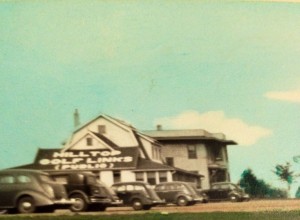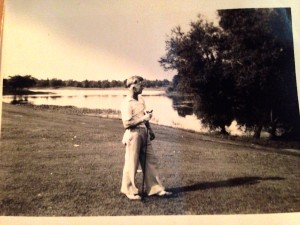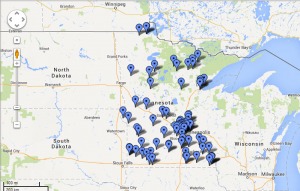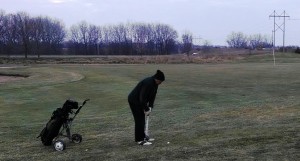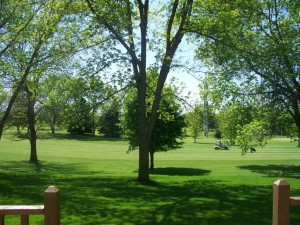Jim Bjork recently contacted me to pass along some golden nuggets about Hilltop Public Golf Links, the subject of Chapter 4, “Bang It Off the Tower,” in “Fore! Gone.”
Bjork’s personal connection to Minnesota is, one might say, thin. “I was conceived in Minnesota (ha!) but born in Illinois after Dad moved in 1954. I moved to Tennessee in 1985,” Bjork wrote as part of an email conversation.
But “Dad,” also known as Clifford Bjork, was intimately connected to Minnesota, and to Hilltop, the lost Columbia Heights golf course. Jim Bjork wrote that his father played in the old Hilltop Twilight League.
The photo atop this post is of Clifford and Maybeth Bjork (Maybeth was Clifford’s wife and Jim’s mother) enjoying a beverage on the Hilltop grounds. The photo is undated, but it certainly goes back a ways, considering Hilltop closed in 1946. (Update, 2/7/14: Jim Bjork said he believes the photo dates to 1940 or 1941.)
The Bjorks look dapper and classy, don’t they, in their golf attire? One small caveat: This might not be exactly what they looked like.
“Mom worked for a place called Pako,” wrote Jim Bjork, “which I believe did work on developing photos. Mom was one of those hired to ‘touch up and give color’ to black and white photos. She colored that picture I sent to you. How she did it I never did learn.”
The background of the photo of the Bjorks is as historically significant as the foreground is becoming. Jim Bjork also passed along a rescanned image of the background in the photo — it is the photo above. Makes you wonder if Hilltop wasn’t visible for miles around in the days it hosted golfers.
“HILLTOP GOLF LINKS (PUBLIC)” shouts the lettering on the clubhouse roof. Considering Hilltop’s perch on high ground in Columbia Heights — the clubhouse was near the intersection of 45th Avenue Northeast and Benjamin Street NE (on the south) and what is now Chatham Road (on the north) — it seems likely the rooftop advertising reached lower ground well to the south and west, to the southern parts of Columbia Heights and maybe even into northeast Minneapolis.
The building next to the clubhouse is interesting as well. I’m not sure whether it is part of the clubhouse or whether it is the manager’s residence, which was next to the clubhouse and still stands today, in the form of a house on the northeast corner of 45th and Chatham. The building in the photo and the modern-day house have similar structures but not identical, so I must say I’m puzzled.
By the way, if Clifford looks much at ease in the photo, it’s for two good reasons. One: “They truly loved each other very much!” Jim Bjork wrote of Clifford and Maybeth. And two: Clifford knew his way around a golf course.
“He once told me his biggest accomplishment in golf was that he played with and beat the Minnesota state amateur and the Minnesota state public links champion in the year they were the champion,” Jim Bjork wrote. “Who they were….where they played I never learned. Dad also caddied in the 1930 US Open at Interlachen. All I know about that is that he caddied for a local pro who did not make the cut.

